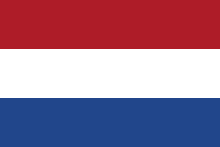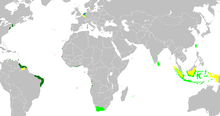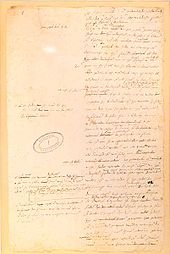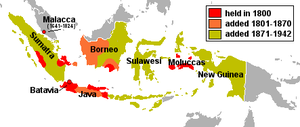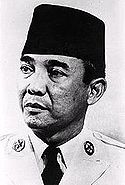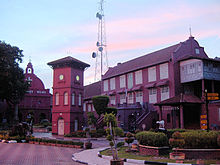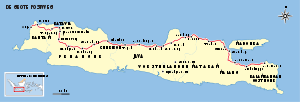- Dutch Empire
-
For a comprehensive list of the territories that formed the Dutch Empire, see Evolution of the Dutch Empire.An anachronous map of the Dutch colonial Empire. Light green: territories administered by or originating from territories administered by the Dutch East India Company; dark green the Dutch West India Company.

The Dutch Empire (Dutch: Nederlands-koloniale Rijk) consisted of the overseas territories controlled by the Dutch Republic and later, the modern Netherlands from the 17th to the 20th century. The Dutch followed Portugal and Spain in establishing an overseas colonial empire, but based on military conquest of already-existing Portuguese and Spanish settlements, and not on discovery and colonisation. For this, they were aided by their skills in shipping and trade and the surge of nationalism accompanying the struggle for independence from Spain. Alongside the British, the Dutch initially built up colonial possessions on the basis of indirect state capitalist corporate colonialism, via the Dutch East and West India Companies. Dutch exploratory voyages such as those led by Willem Barents, Henry Hudson and Abel Tasman revealed to Europeans vast new territories.
With Dutch naval power rising rapidly as a major force from the late 16th century, the Netherlands dominated global commerce during the second half of the 17th century during a cultural flowering known as the Dutch Golden Age. The Netherlands lost many of its colonial possessions, as well as its global power status, to the British when the metropole fell to French armies during the Revolutionary Wars. The restored portions of the Dutch Empire, notably the Dutch East Indies and Suriname, remained under Dutch control until the decline of European imperialism following World War II.
Today, the Netherlands are part of a federacy called the Kingdom of the Netherlands. As of October 10, 2010, the constituent countries within the Kingdom of the Netherlands are the Netherlands, Aruba, Curaçao, and Sint Maarten.
Contents
Origins (1543–1602)
The territories that would later form the Dutch Republic were originally part of a loose federation of seventeen provinces, which Charles V, Holy Roman Emperor and King of Spain had inherited and brought under his direct rule in 1543. In 1567 a Protestant revolt broke out against rule by Roman Catholic Spain, sparking the Eighty Years War. Led by William of Orange, independence was declared in the 1581 Act of Abjuration. The revolt resulted in the establishment of an independent Protestant republic in the north, although Spain did not officially recognize Dutch independence until 1648.
The coastal provinces of Holland and Zeeland had for a long time prior to Spanish rule been important hubs of the European maritime trade network. Their geographical location provided convenient access to the markets of France, Germany, England and the Baltic.[1] The war with Spain led many financiers and traders to emigrate from Antwerp a major city in Flanders and then one of Europe's most important commercial centres, to Dutch cities, particularly Amsterdam,[2] which became Europe's foremost centre for shipping, banking, and insurance.[3] Efficient access to capital enabled the Dutch in the 1580s to extend their trade networks beyond northern Europe to new markets in the Mediterranean and the Levant. In the 1590s, Dutch ships began to trade with Brazil and the Dutch Gold Coast of Africa, and towards the Indian Ocean and the source of the lucrative spice trade.[4] This brought the Dutch into direct competition with Portugal, which had dominated these trade networks for several decades, and had established colonial outposts on the coasts of Brazil, Africa and the Indian Ocean to facilitate them. The rivalry with Portugal, however, was not entirely economic: from 1580, after the battle of Ksar El Kebir, the Portuguese crown had been joined to that of Spain in an "Iberian Union" under Philip II of Spain. By attacking Portuguese overseas possessions, the Dutch forced Spain to divert financial and military resources away from its attempt to quell Dutch independence.[5] Thus began the several decade-long Dutch-Portuguese War.
In 1594, the "Company of Far Lands" was founded in Amsterdam, with the aim of sending two fleets to the spice islands of Maluku.[6] The first fleet sailed in 1596 and returned in 1597 with a cargo of pepper, which more than covered the costs of the voyage. The second voyage (1598–1599), returned its investors a 400% profit.[7] The success of these voyages led to the founding of a number of companies competing for the trade. The competition was counterproductive to the companies' interests as it threatened to drive up the price of spices at their source in Indonesia whilst driving them down in Europe.[7]
Rise of Dutch hegemony (1602–1652)
As a result of the problems caused by intercompany rivalry, the Dutch East India Company (Dutch: Verenigde Oost-Indische Compagnie, VOC) was founded in 1602. The charter awarded to the Company by the States-General granted it sole rights, for an initial period of 21 years, to Dutch trade and navigation east of the Cape of Good Hope and west of the Straits of Magellan. The directors of the company, the "Heeren XVII" were given the legal authority to establish "fortresses and strongholds", to sign treaties, to enlist its own army and navy, and to wage defensive war.[8] The company itself was founded as a joint stock company, similarly to its English rival that had been founded two years earlier, the English East India Company. In 1621 the Dutch West India Company was set up and given a twenty five year monopoly to those parts of the world that were not controlled by its East India counterpart: the Atlantic, the Americas and the west coast of Africa.[9]
Asia
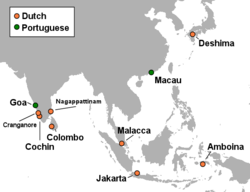 The primary Dutch and Portuguese settlements in Asia, c. 1665. With the exception of Jakarta and Deshima, all had been captured by the Dutch East India Company from Portugal.[10]
The primary Dutch and Portuguese settlements in Asia, c. 1665. With the exception of Jakarta and Deshima, all had been captured by the Dutch East India Company from Portugal.[10]
The VOC began immediately to prise away the string of coastal fortresses that at the time comprised the Portuguese Empire. The settlements were isolated, difficult to reinforce if attacked, and prone to being picked off one by one, but nevertheless the Dutch only enjoyed mixed success in its attempts to do so.[11] Amboina was captured from the Portuguese in 1605, but an attack on Malacca the following year narrowly failed in its objective to provide a more strategically located base in the East Indies with favourable monsoon winds.[12] The Dutch found what they were looking for in Jakarta, conquered by Jan Coen in 1619, later renamed Batavia after the putative Dutch ancestors the Batavians, and which would become the capital of the Dutch East Indies. Meanwhile, the Dutch continued to drive out the Portuguese from their bases in Asia. Malacca finally succumbed in 1641 (after a second attempt to capture it), Colombo in 1656, Ceylon in 1658, Nagappattinam in 1662 and Cranganore and Cochin in 1662.[10] Goa, the capital of the Portuguese Empire in the East, was unsuccessfully attacked by the Dutch in 1603 and 1610. Whilst the Dutch were unable in four attempts to capture Macau[13] from where Portugal monopolised the lucrative China-Japan trade, the Japanese shogunate's increasing suspicion of the intentions of the Catholic Portuguese led to their expulsion in 1639. Under the subsequent sakoku policy, from 1639 till 1854 (215 years) the Dutch were the only European power allowed to operate in Japan, confined in 1639 to Hirado and then from 1641 at Deshima. In the mid 17th century the Dutch also explored the western Australian coasts, naming many places.
The Dutch colonised Mauritius in 1638, several decades after three ships out of the Dutch Second Fleet sent to the Spice Islands were blown off course in a storm and landed in 1598. They named it in honour of Prince Maurice of Nassau, the Stadtholder of the Netherlands. The Dutch found the climate hostile and abandoned the island after several further decades.
By the middle of the 17th century, the Dutch had overtaken Portugal as the dominant player in the spice and silk trade, and in 1652 founded a colony at Cape Town on the coast of South Africa, as a way-station for its ships on the route between Europe and Asia.[14] After the first settlers spread out around the Company station, nomadic white livestock farmers, or Trekboers, moved more widely afield, leaving the richer, but limited, farming lands of the coast for the drier interior tableland. In 1795 the heavily taxed Boers of the frontier districts, who received no protection against the Africans, expelled the officials of the Dutch East India Company, and established independent governments at Swellendam and at Graaff Reinet.
Between 1602 and 1796, the VOC sent almost a million Europeans to work in the Asia trade.[15] The majority died of disease or made their way back to Europe, but some of them made the Indies their new home.[16] Interaction between the Dutch and native population mainly took place in Sri Lanka and the modern Indonesian Islands. Through the centuries there developed a relatively large Dutch-speaking population of mixed Dutch and Indonesian descent, known as Indos or Dutch-Indonesians.
Americas
In the Atlantic, the West India Company concentrated on wresting from Portugal its grip on the sugar and slave trade, and on opportunistic attacks on the Spanish treasure fleets on their homeward bound voyage.[18] Bahia on the north east coast of Brazil was captured in 1624 but only held for a year before it was recaptured by a joint Spanish-Portuguese expedition. In 1628, Piet Heyn captured the entire Spanish treasure fleet, and made off with a vast fortune in precious metals and goods that enabled the Company two years later to pay its shareholders a cash dividend of 70%,[19] though the Company was to have relatively few other successes against the Spanish.[20] In 1630, the Dutch occupied the Portuguese sugar-settlement of Pernambuco and over the next few years pushed inland, annexing the sugar plantations that surrounded it. In order to supply the plantations with the manpower they required, a successful expedition was launched in 1637 from Brazil to capture the Portuguese slaving post of Elmina,[9] and in 1641 successfully captured the Portuguese settlements in Angola.[21] In 1642 the Dutch captured the Portuguese possession of Axim in Africa. By 1650, the West India Company was firmly in control of both the sugar and slave trades, and had occupied the Caribbean islands of Sint Maarten, Curaçao, Aruba and Bonaire in order to guarantee access to the islands' salt-pans.[22]
Unlike in Asia, Dutch successes against the Portuguese in Brazil and Africa were short-lived. Years of settlement had left large Portuguese communities under the rule of the Dutch, who were by nature traders rather than colonisers.[23] In 1645, the Portuguese community at Pernambuco rebelled against their Dutch masters,[24] and by 1654, the Dutch had been ousted from Brazil.[25] In the intervening years, a Portuguese expedition had been sent from Brazil to recapture Luanda in Angola, by 1648 the Dutch were expelled from there also.
On the north-east coast of North America, the West India Company took over a settlement that had been established by the Company of New Netherland (1614–18) at Fort Orange at Albany on the Hudson River,[26] relocated from Fort Nassau which had been founded in 1614. The Dutch had been sending ships annually to the Hudson River to trade fur since Henry Hudson's voyage of 1609.[27] In order to protect its precarious position at Albany from the nearby English and French, the Company founded the fortified town of New Amsterdam in 1625 at the mouth of the Hudson, encouraging settlement of the surrounding areas of Long Island and New Jersey.[28] The fur trade ultimately proved impossible for the Company to monopolise due to the massive illegal private trade in furs, and the settlement of New Netherland was unprofitable.[29] In 1655, the nearby colony of New Sweden on the Delaware River was forcibly absorbed into New Netherland after ships and soldiers were sent to capture it by the Dutch governor, Pieter Stuyvesant.[30]
Ever since its inception, the Dutch East India Company had been in competition with its counterpart, the English East India Company, founded two years earlier but with a capital base eight times smaller,[31] for the same goods and markets in the East. In 1619, the rivalry resulted in the Amboyna massacre, when several English Company men were executed by agents of the Dutch. The event remained a source of English resentment for several decades, and in the late 1620s the English Company shifted its focus from Indonesia to India.[31]
In 1643 the Dutch West India Company established a settlement in the ruins of the Spanish settlement of Valdivia, in southern Chile. The purpose of the expedition was to gain a foothold on the west coast of the Americas, an area that - at the time - was almost an internal sea of Spain, and to extract gold from nearby mines. Uncooperative indigenous peoples that had forced the Spanish to leave Valdivia in 1604 contributed to get the expedition to leave after some months of occupation. This occupation triggered the return of the Spanish to Valdivia and the building of one of the largest defensive complexes of colonial America.
Rivalry with Great Britain and France (1652–1795)

In 1651, the English parliament passed the first of the Navigation Acts which excluded Dutch shipping from the lucrative trade between England and its Caribbean colonies, and led directly to the outbreak of hostilities between the two countries the following year, the first of three Anglo-Dutch Wars that would last on and off for two decades and slowly erode Dutch naval power to England's benefit.[33][34]
The Second Anglo-Dutch War was precipitated in 1664 when English forces moved to capture New Netherland. Under the Treaty of Breda (1667), New Netherland was ceded to England in exchange for the English settlements in Suriname, which had been conquered by Dutch forces earlier that year. Though the Dutch would again take New Netherland in 1673, during the Third Anglo-Dutch War, it was returned to England the following year, thereby ending the Dutch Empire in continental North America, but leaving behind a large Dutch community under English rule that persisted with its language, church and customs until the mid-18th century.[35] In South America, the Dutch seized Cayenne from the French in 1658 and drove off a French attempt to retake it a year later. However, it was returned to France in 1664 since the colony proved to be unprofitable. It was recaptured by the Dutch in 1676, but was returned again a year later, this time permanently. The Glorious Revolution of 1688 saw the Dutch William of Orange ascend to the throne, and win the English, Scottish, and Irish crowns, ending eighty years of rivalry between the Netherlands and England, while the rivalry with France remained strong.
During the American Revolutionary War, Britain declared war on the Netherlands, the Fourth Anglo-Dutch War, in which Britain seized the Dutch colony of Ceylon. Under the Peace of Paris (1783), Ceylon was returned to the Netherlands and Negapatnam ceded to Britain.
Napoleonic era (1795–1815)
In 1795, the French revolutionary army invaded the Dutch Republic and turned the nation into a satellite of France, named the Batavian Republic. Britain, which was at war with France, soon moved to occupy Dutch colonies in Asia, South Africa and the Caribbean.
Under the terms of the Treaty of Amiens signed by Britain and France in 1802, the Cape Colony and the islands of the Dutch West Indies that the British had seized were returned to the Republic. Ceylon was not returned to the Dutch and was made a British Crown Colony. After the outbreak of hostilities between Britain and France again in 1803, the British retook the Cape Colony. The British also invaded the island of Java in 1810 which resulted in Anglo-Dutch Java War. The entire colony fell under British control in 1811.
In 1806 Napoleon dissolved the Batavian Republic and established a monarchy with his brother, Louis, on the throne as King of Holland. Louis was removed from power by Napoleon in 1810, and the country was ruled directly from France until its liberation in 1813. The following year, the independent Netherlands signed the Anglo-Dutch Treaty of 1814 with Britain. All of the colonies that Britain had seized were returned to the Netherlands, with the exception of the Cape Colony and Guyana.
Post-Napoleonic era (1815–1945)
After Napoleon's defeat in 1815, Europe's borders were redrawn at the Congress of Vienna. For the first time since the declaration of independence from Spain in 1581, the Dutch were reunited with the Southern Netherlands in a constitutional monarchy, the United Kingdom of the Netherlands. The union lasted just 15 years. In 1830, a revolution in the southern half of the country led to the de facto independence of the new state of Belgium.
The bankrupt Dutch East India Company was liquidated on 1 January 1800,[37] and its territorial possessions were nationalised as the Dutch East Indies. Anglo-Dutch rivalry in Southeast Asia continued to fester over the port of Singapore, which had been ceded to the British East India Company in 1819 by the sultan of Johore. The Dutch claimed that a treaty signed with the sultan's predecessor the year earlier had granted them control of the region. However, the impossibility of removing the British from Singapore, which was becoming an increasingly important centre of trade, became apparent to the Dutch, and the disagreement was resolved with the Anglo-Dutch Treaty of 1824. Under its terms, the Netherlands ceded Malacca and their bases in India to the British, and recognised the British claim to Singapore. In return, the British handed over Bencoolen and agreed not to sign treaties with rulers in the "islands south of the Straits of Singapore". Thus the archipelago was divided into two spheres of influence: a British one, on the Malay Peninsula, and a Dutch one in the East Indies.[38]
For most of the Dutch East Indies history, and that of the VOC before it, Dutch control over their territories was often tenuous, but was expanded over the course of the 19th century. Only in the early 20th century did Dutch dominance extend to what was to become the boundaries of modern-day Indonesia. Although highly populated and agriculturally productive Java was under Dutch domination for most of the 350 years of the combined VOC and Dutch East Indies era, many areas remained independent for much of this time including Aceh, Lombok, Bali and Borneo.[39]
In 1871, all of the Dutch possessions on the Dutch Gold Coast were sold to Britain.
The Dutch West India company was abolished in 1791, and its colonies in Suriname and the Caribbean brought under the direct rule of the state.[40] The economies of the Dutch colonies in the Caribbean had been based on the smuggling of goods and slaves into Spanish America, but with the end of the slave trade in 1814 and the independence of the new nations of South and Central America from Spain, profitability rapidly declined. Dutch traders moved en masse from the islands to the United States or Latin America, leaving behind a small populations with little income and which required subsidies from the Dutch government. The Antilles were combined under one administration with Suriname from 1828 to 1845. Slavery was not abolished in the Dutch Caribbean colonies until 1863, long after those of Britain and France, though by this time only 6,500 slaves remained. In Suriname, slave holders demanded compensation from the Dutch government for freeing slaves, whilst in Sint Maarten, abolition of slavery in the French half in 1848 led slaves in the Dutch half to take their own freedom.[41] In Suriname, after the abolition of slavery, Chinese workers were encouraged to immigrate as indentured labourers,[42] as were Javanese, between 1890 and 1939.[43]
Decolonization (1942–1975)
Indonesia
In January 1942, Imperial Japan invaded the Netherlands East Indies.[44] Two months later the Dutch surrendered in Java with Indonesians initially welcoming the Japanese as liberators.[45] The subsequent Japanese occupation of Indonesia during the remainder of World War II saw the fundamental dismantling of the Dutch colonial state's economic, political and social structures, replacing it with a Japanese regime.[46] In the decades before the war, the Dutch had been overwhelmingly successful in suppressing the small nationalist movement in Indonesia such that the Japanese occupation proved fundamental for Indonesian independence.[46] However, the Indonesian Communist Party founded by Dutch socialist Henk Sneevliet in 1914, popular also with Dutch workers and sailors at the time, was in strategic alliance with Sarekat Islam (q.v.) as early as 1917 until the Proclamation of Indonesian Independence and was particularly important in the fight against Japanese occupation of the Dutch East Indies in the Second World War. The Japanese encouraged and backed Indonesian nationalism in which new indigenous institutions were created and nationalist leaders such as Sukarno were promoted. The internment of all Dutch citizens meant that Indonesians filled many leadership and administrative positions, although the top positions were still held by the Japanese.[46]
Two days after the Japanese surrender in August 1945, Sukarno and fellow nationalist leader Hatta unilaterally declared Indonesian independence. A four and a half-year struggle followed as the Dutch tried to re-establish their colony. Dutch forces eventually re-occupied most of the colonial territory and a guerrilla struggle ensued. The majority of Indonesians, and - ultimately - international opinion, favored independence, and in December 1949, the Netherlands formally recognized Indonesian sovereignty. Under the terms of the 1949 agreement, Western New Guinea remained under the auspices of Netherlands New Guinea. The new Indonesian government under President Sukarno pressured for the territory to come under Indonesian control as Indonesian nationalists initially intended. Following United States pressure, the Netherlands transferred it to Indonesia under the 1962 New York Agreement.
Suriname and the Netherlands Antilles
In 1954, under the "Charter for the Kingdom of the Netherlands", the Netherlands, Suriname and the Netherlands Antilles (at the time including Aruba) became a composite kingdom. The former colonies were granted autonomy save for certain matters including defense, foreign affairs and citizenship, which were the responsibility of the Realm. In 1969, unrest in Curaçao led to Dutch marines being sent to quell rioting. In 1973, negotiations started in Suriname for independence, and full independence was granted in 1975, with 60,000 emigrants taking the opportunity of moving to the Netherlands. In 1986, Aruba was allowed to secede from the Netherlands Antilles federation, and was pressured by the Netherlands to move to independence within ten years. However, in 1994, it was agreed that its status as a Realm in its own right could continue.[47]
On October 10, 2010, the Netherlands Antilles were dissolved. Effective on that date, Curaçao and Sint Maarten acceded to the same country status within the Kingdom that Aruba already enjoyed. The islands of Bonaire, Sint Eustatius and Saba were granted a status similar to Dutch municipalities, and are now sometimes referred to as the Caribbean Netherlands.
Legacy
In general the Dutch do not celebrate their imperial past and anti-colonial sentiments prevail since the 1960s. Subsequently colonial history is not featured prominently in Dutch schoolbooks. This perspective on their imperial past only recently shifted with prime minister Jan Peter Balkenende's contentious call for the return of the VOC mentality.[48]
Dutch diaspora
In some Dutch colonies there are major ethnic groups of Dutch ancestry descending from emigrated Dutch settlers. In South Africa the Boers and Cape Dutch collectively known as the Afrikaners. The Burgher people of Sri Lanka and the Indo people of Indonesia as well as the Creoles of Suriname (previously known as Dutch Guyana) are mixed race people of Dutch descent.
In the USA there have been three American presidents of Dutch descent: Martin Van Buren, the first president who was not of British descent, and whose first language was Dutch, the 26th president Theodore Roosevelt and Franklin D. Roosevelt, the 32nd president, elected to four terms in office (1933 to 1945) and the only U.S. president to have served more than two terms.
Dutch language
Despite the Dutch presence in Indonesia for almost three hundred and fifty years, the Dutch language has no official status[50] and the small minority that can speak the language fluently are either educated members of the oldest generation, or employed in the legal profession,[51] as some legal codes are still only available in Dutch.[52] The Indonesian language inherited many words from Dutch, both in words for everyday life, and as well in scientific or technological terminology.[53] One scholar argues that 20% of Indonesian words can be traced back to Dutch words.[54]
The century and half of Dutch rule in Ceylon and southern India left few to no traces of the Dutch language.[citation needed] Today, in Suriname, Dutch is the official language[55] and 58 percent of the population speak it as their mother tongue. Twenty-four percent of the population speaks Dutch as a second language, and in total 82 percent of the population can speak Dutch.[56] In Aruba, Bonaire, and Curaçao, Dutch is the official language but spoken as a first language by only seven to eight percent of the population,[57][58] although most people on the islands can speak the language and the education system on these islands is in Dutch at some or all levels.[59] The population of the three northern Antilles, Sint Maarten, Saba, and Sint Eustatius, is predominantly English-speaking.
In New Jersey in the United States, an extinct dialect of Dutch, Jersey Dutch, spoken by descendants of 17th century Dutch settlers in Bergen and Passaic counties, was noted to still be spoken as late as 1921.[60]
The greatest linguistic legacy of the Netherlands was in its colony in South Africa, which attracted large numbers of Dutch farmer (in Dutch, Boer) settlers, who spoke a simplified form of Dutch called Afrikaans, which is largely mutually intelligible with Dutch. After the colony passed into British hands, the settlers spread into the hinterland, taking their language with them. As of 2005, there were 10 million people for whom Afrikaans is either a primary and secondary language, compared with over 22 million speakers of Dutch.[61][62]
Other Creole languages with Dutch linguistic roots are Papiamento still spoken in Aruba, Bonaire, Curaçao, and Sint Eustatius; Saramaccan and Sranan Tongo still spoken in Suriname; Berbice spoken but in danger of extinction in Guyana; Pecok spoken but in danger of extinction in Indonesia and the Netherlands; Albany Dutch spoken but in danger of extinction in the USA.
Extinct Dutch-based creole languages include: Skepi (Guyana); Negerhollands (aka "Negro Dutch"), Jersey Dutch and Mohawk Dutch (USA) and Javindo (Java).
Placenames
Some towns of New York and areas of New York City, once part of the colony of New Netherland have names of Dutch origin, such as Brooklyn (after Breukelen), Flushing (after Vlissingen), the Bowery (after Bouwerij, construction site), Harlem (after Haarlem), Coney Island (from Conyne Eylandt, modern Dutch spelling Konijneneiland: Rabbit island) and Staten Island (meaning "Island of the States"). The last Director-General of the colony of New Netherland, Pieter Stuyvesant, has bequeathed his name to a street, a neighborhood and a few schools in New York City, and the town of Stuyvesant. Many of the towns and cities along the Hudson in upstate New York have placenames with Dutch origins (for example Yonkers, Hoboken, Haverstraw, Newburgh, Staatsburg, Catskill, Kinderhook, Coeymans, Rensselaer, Watervliet).
Many towns and cities in Suriname share names with cities in the Netherlands, such as Alkmaar and Groningen. The capital of Curaçao is named Willemstad and the capital of Aruba is named Oranjestad. Both are named after the Dutch King Willem van Oranje-Nassau (William of Orange-Nassau) - the first heir to the Dutch House of Orange.
Half of South Africa's major cities have Dutch names i.e. Johannesburg, Kaapstad, Vereeniging, Bloemfontein and Vanderbijlpark.
The country name New Zealand originated with Dutch cartographers, who called the islands Nova Zeelandia, after the Dutch province of Zeeland.[63] British explorer James Cook subsequently anglicised the name to New Zealand.[64]
The Australian island state Tasmania is named after Dutch explorer Abel Tasman, who made the first reported European sighting of the island on 24 November 1642. He first named the island Anthony van Diemen's Land after his sponsor Anthony van Diemen, the Governor of the Dutch East Indies. The name was later shortened to Van Diemen's Land by the British. It was officially renamed in honour of its first European discoverer on 1 January 1856.[65] Arnhem Land is named after the Dutch city of Arnhem.
Architecture
In the Surinamese Capital of Paramaribo, the Dutch Fort Zeelandia still stands today. In the centre of Malacca, Malaysia, the Stadthuys Building and Christ Church still stand. There are still archaeological remains of Fort Goede Hoop (modern Hartford, Connecticut) and Fort Orange (modern Albany, New York).[67]
Dutch architecture is easy to see in Aruba, Curaçao, and Bonaire. The Dutch style buildings are especially visible in Willemstad, with its steeply pitched gables, large windows and soaring finials.[68]
During the period of Dutch colonisation in South Africa, a distinctive type of architecture, known as Cape Dutch architecture, was developed.
Although the Dutch already started erecting buildings shortly after they arrived on the shores of Batavia, most Dutch-built constructions still standing today in Indonesia stem from the 19th and 20th centuries. Forts from the colonial era, used for defense purposes, still line a number of major coastal cities across the archipelago. The largest number of Dutch buildings is found on Java, particularly in the big cities such as Jakarta, Bandung, Semarang, Yogyakarta, Surabaya and Malang. “In the beginning (of the Dutch presence), Dutch construction on Java was based on colonial architecture which was modified according to the tropical and local cultural conditions,” Indonesian art and design professor Pamudji Suptandar wrote.[69] This was dubbed arsitektur Indis (Indies architecture), which combines the existing traditional Hindu-Javanese style with European forms.[70]
Many public buildings still standing and in use in Jakarta, such as the presidential palace, the finance ministry and the performing arts theatre, were built in the 19th century in the classicist style. As the 20th century approached, the number of Dutch people in Indonesia increase, and smaller residential dwellings were built, many in the more modern art-deco style. The most ‘Dutch’ city in Indonesia, architecturally speaking, is Bandung, some 180 kilometres east of Jakarta. This city, situated on the higher plains of West Java, was largely rural grounds until the Dutch decided to develop it into a city in the late 19th century.
Since Indonesia’s independence, few governments have shown interest in the conservation of historical buildings. Many architecturally grand buildings have been torn down in the past decades to erect shopping centres or office buildings e.g. Hotel des Indes (Batavia). Presently, however, more Indonesians have become aware of the value of preserving their old buildings.
“A decade ago, most people thought I was crazy when they learned of my efforts to save the old part of Jakarta. A few years later, the negative voices started to disappear, and now many people are starting to think with me: how are we going to save our city. In the past using the negative sentiment towards the colonial era was often used as an excuse to disregard protests against the demolition of historical buildings. An increasing number of people now see the old colonial buildings as part of their city’s overall heritage rather than focusing on its colonial aspect.”, leading Indonesian architect and conservationist Budi Lim said.[71]
Infrastructure
Beyond Indonesia’s art deco architecture also much of the country’s rail and road infrastructure as well as its major cities were built during the colonial period.[72][73] Many of Indonesia’s main cities were mere rural townships before colonial industrialization and urban development.[74] Examples on Java include the capital Jakarta and Bandung, outside Java examples include Ambon and Menado city. Most main railroads and rail stations on Java as well as the main road, called Daendels Great Post Road (Dutch: Grote Postweg)[75] after the Governor General commissioning the work, connecting west to east Java were also build during the Dutch East Indies era.
Between 1800 to 1950 Dutch engineers created an infrastructure including 67,000 kilometers (42,000 mi) of roads, 7,500 kilometers (4,700 mi) of railways, many large bridges, modern irrigation systems covering 1.4 million hectares (5,400 sq mi) of rice fields, several international harbors, and 140 public drinking water systems. These Dutch constructed public works became the material base of the colonial and postcolonial Indonesian state.[76]
Agriculture
Crops such like coffee, tea, cacao, tobacco and rubber were all introduced by the Dutch. The Dutch were the first to start the spread of the coffee plant in Central and South America, and by the early 19th century Java was the third largest producer in the world.[77] In 1778 the Dutch brought cacao from the Philippines to Indonesia and commenced mass production.[78] Currently Indonesia is the world's second largest producer of natural rubber, a crop that was introduced by the Dutch in the early 20th century.[79] Tobacco was introduced from the Americas and in 1863 the first plantation was established by the Dutch. Today Indonesia is not only the oldest industrial producer of tobacco, but also the second largest consumer of tobacco.[80]
See also
- Dutch colonization of the Americas
- Dutch East India Company
- Dutch West India Company
- Dutch Language Union
- List of Dutch East India Company trading posts
References
Bibliography
- Ammon, Ulrich (2005). Sociolinguistics.
- Baker, Colin (1998). Encyclopedia of Bilingualism and Bilingual Education. Multilingual Matters.
- Booij, G.E. (1995). The Phonology of Dutch.
- Boxer, C.R. (1965). The Dutch Seaborne Empire 1600–1800. Hutchinson.
- Boxer, C.R. (1969). The Portuguese Seaborne Empire 1415–1825. Hutchinson.
- Davies, K.G. (1974). The North Atlantic World in the Seventeenth Century. University of Minnesota.
- McEvedy, Colin (1988). The Penguin Historical Atlas of the North America. Viking.
- McEvedy, Colin (1998). The Penguin Historical Atlas of the Pacific. Penguin.
- Ostler, Nicholas (2005). Empires of the Word: A Language History of the World. Harper Collins.
- Rogozinski, Jan (2000). A Brief History of the Caribbean. Plume.
- SarDesai, D.R. (1997). Southeast Asia: Past and Present. Westview.
- Scammel, G.V. (1989). The First Imperial Age: European Overseas Expansion c. 1400–1715. Routledge.
- Sneddon, James (2003). The Indonesian Language: Its History and Role in Modern Society. UNSW Press.
- Shipp, Steve (1997). Macau, China: A Political History of the Portuguese Colony's Transition to Chinese Rule. McFarland.
- Taylor, Alan (2001). American Colonies: The Settling of North America. Penguin.
- Vickers, Adrian (2005). A History of Modern Indonesia. Cambridge University Press. ISBN 0-521-54262-6.
Notes
- ^ Boxer (1965), p.6.
- ^ Boxer (1965), p.19.
- ^ Taylor (2001), p. 248.
- ^ Boxer (1965), p.20.
- ^ Scammel (1989), p.20.
- ^ Boxer (1965), p.22.
- ^ a b Boxer (1965), p.23.
- ^ Boxer (1965), p.24.
- ^ a b Rogozinski (2000), p.62.
- ^ a b Boxer (1969), p.24.
- ^ Boxer (1969), p.23.
- ^ Boxer (1965), p.189.
- ^ Shipp, p.22.
- ^ Taylor (2001), p.250.
- ^ Nomination VOC archives for Memory of the World Register
- ^ Easternization of the West: Children of the VOC
- ^ Reproduced from Boxer (1965), p.101.
- ^ Taylor (2001), p.62.
- ^ Taylor (2001), p.63.
- ^ Boxer (1965), p.26.
- ^ Boxer (1969), p.112.
- ^ Taylor (2001), p.65.
- ^ Boxer (1969), p.120.
- ^ Boxer (1965), p.26
- ^ Facsimile of manuscript regarding the surrender of Dutch Brazil:Cort, Bondigh ende Waerachtigh Verhael Wan't schandelyck over-geven ende verlaten vande voorname Conquesten van Brasil...;
- ^ Davies (1974), p.89.
- ^ Taylor (2001), p.251.
- ^ Taylor (2001), p.252.
- ^ Taylor (2001), p.253.
- ^ Taylor (2001), p.255.
- ^ a b McEvedy (1998), p.44.
- ^ Boxer (1965), p.261
- ^ McEvedy (1988), p.46.
- ^ Taylor (2001), p.259
- ^ Taylor (2001), p.260
- ^ SarDesai (1997), p.88.
- ^ Ricklefs, M.C. (1991). A History of Modern Indonesia Since c.1300, 2nd Edition. London: MacMillan. p. 110. ISBN 0-333-57689-6.
- ^ SarDesai, pp.92–93.
- ^ Witton, Patrick (2003). Indonesia. Melbourne: Lonely Planet. pp. 23–25. ISBN 1-74059-154-2.; Schwarz, A. (1994). A Nation in Waiting: Indonesia in the 1990s. Westview Press. pp. 3–4. ISBN 1-86373-635-2.
- ^ Rogozinski (1999), pp.213
- ^ Rogozinski (1999), pp.213–4
- ^ The Chinese in Suriname
- ^ Javanese in Suriname strive to preserve origins
- ^ L., Klemen, 1999–2000, The Netherlands East Indies 1941–42, "Forgotten Campaign: The Dutch East Indies Campaign 1941-1942".
- ^ Ricklefs (1991), p. 195. Vickers (2005), pp.85, 85.
- ^ a b c Vickers (2005), page 85
- ^ Rogozinski, pp.296–7
- ^ A 2011 series of critical analysis featured in Inside Indonesia, the English language media forum of the Indonesian Resources and Information Program.
- ^ Lewes Chamber of Commerce & Visitors Bureau, Inc
- ^ Baker (1998), p.202.
- ^ Ammon (2005), p.2017.
- ^ Booij (1995), p.2
- ^ Sneddon (2003), p.162.
- ^ A Hidden Language – Dutch in Indonesia See also: List of Dutch loan words in Indonesian
- ^ CIA - The World Factbook - Suriname
- ^ Bron: Zevende algemene volks- en woningtelling 2004, Algemeen Bureau voor de Statistiek
- ^ CIA - The World Factbook - Netherlands Antilles
- ^ CIA - The World Factbook - Aruba
- ^ Languages of Aruba
- ^ Jersey Dutch
- ^ "About the Netherlands". Dutch Ministry of Foreign Affairs. Archived from the original on 2008-08-22. http://web.archive.org/web/20080822163610/http://www.minbuza.nl/en/welcome/Netherlands#a7. Retrieved 2008-08-23.
- ^ "Hoeveel mensen spreken Nederlands als moedertaal? (How many people speak Dutch as mother tongue?)". Nederlandse Taalunie. 2005. http://taalunieversum.org/taal/vragen/antwoord/4/. Retrieved 2008-08-23.
- ^ Wilson, John (21 September 2007). "Tasman’s achievement". Te Ara – the Encyclopedia of New Zealand. http://www.teara.govt.nz/en/european-discovery-of-new-zealand/3. Retrieved 16 February 2008.
- ^ Note:The first European name for New Zealand was Staten Landt, the name given to it by the Dutch explorer Abel Tasman, who in 1642 became the first European to see the islands. Tasman assumed it was part of a southern continent connected with land discovered in 1615 off the southern tip of South America by Jacob Le Maire, which had been named Staten Landt, meaning "Land of the (Dutch) States-General". See:The Discovery of New Zealand
- ^ 'Select chronology of renaming' Parliament of Tasmania http://www.parliament.tas.gov.au/php/BecomingTasmania/BTAppend2.htm Retrieved 15 June 2009.
- ^ Tourism.gov.my
- ^ Dutch Colonial Remains
- ^ Willemstad, Curaçao, Netherlands Antilles Heritage Site of the Month
- ^ (Indonesian)Suptandar, Pamudji Tokoh Pejuang Kemerdekaan, Pembangunan, Dan Pendidikan. (Publisher: Penerbit Universitas Trisakti, Jakarta) ISBN 979-8398-86-6
- ^ (Indonesian)Article by Dr. Mauro Rahardjo, architect, lecturer and founder of Feng Shui School Indonesia and Indonesian Feng Shui Society. [1]
- ^ Lim, Budy The past in the present: architecture in Indonesia. (Publisher: NAI Rotterdam, 19 January 2007) See also: [2]; [3] and [4]
- ^ Page, Melvin and Sonnenburg, Penny Colonialism: an international social, cultural, and political encyclopedia. (publisher: ABC-CLIO, Santa Barbara, ca, usa, 2003) P.716 [5]
- ^ For images see the website of the 'Royal Institute of language, geography and ethnology' (KITLV): [6]
- ^ Page, Melvin and Sonnenburg, Penny Colonialism: an international social, cultural, and political encyclopedia. (publisher: ABC-CLIO, Santa Barbara, ca, usa, 2003) P.215, 716 [7]
- ^ Daendels (1762-1818), a pro-French Governor-General, originally named the road: La Grand Route. In Indonesian it is called Jalan Raya Pos. A documentary narrated by Indonesian author Pramoedya Ananta Toer was made about the road in 1996. See: [8]
- ^ Ravesteijn, Wim "Between Globalization and Localization: The Case of Dutch Civil Engineering in Indonesia, 1800-1950," in Comparative Technology Transfer and Society, Volume 5, Number 1, 1 April 2007(Publisher: Project MUSE [9]) pp. 32-64. [10] ISSN: 1542-0132
- ^ International Coffee organization
- ^ Chocolate website.
- ^ Penot, Eric. ‘From shifting agriculture to sustainable rubber complex agroforestry systems (jungle rubber) in Indonesia: an history of innovations production and adoption process.’ (Bogor, 1997).[11]
- ^ (Indonesian)[12]
Further reading
- Andeweg, Rudy C.; Galen A. Irwin (2005). Governance and Politics of the Netherlands (2nd ed. ed.). Palgrave Macmillan. ISBN 1403935297.
- Boxer, C. R. (1957). The Dutch in Brazil, 1624–1654. Oxford: Clarendon.
- Bromley, J.S.; E.H. Kossmann. Britain and the Netherlands in Europe and Asia.
- Corn, Charles. The Scents of Eden: A History of the Spice Trade.
- Elphick, Richard; Hermann Giliomee (1989). The Shaping of South African Society, 1652–1840 (2nd ed. ed.). Cape Town: Maskew Miller Longman. ISBN 0819562114.
- Gaastra, Femme S. (2003). The Dutch East India Company. Zutphen, Netherlands: Walburg.
- Postma, Johannes M. (1990). The Dutch in the Atlantic Slave Trade, 1600–1815. Cambridge, U.K.: Cambridge University Press. ISBN 0521365856.
- Wesseling, H.L.. Imperialism and Colonialism: Essays on the History of Colonialism.
External links
- (Dutch) De VOCsite
- Dutch and Portuguese Colonial History
- (Dutch) VOC Kenniscentrum
- Archives of the Dutch East and West India Companies
Dutch Empire Colonies and trading posts of the Dutch East India Company (1602-1798) GovernoratesAmbon · Banda · Batavia · Cape Colony · Ceylon · Coromandel · Formosa · Northeast coast of Java · Makassar · Malacca · MoluccasDirectoratesCommandmentsResidenciesColonies and trading posts of the Dutch West India Company (1621-1792) Colonies in the AmericasAcadia · Berbice† · Cayenne · Curaçao and Dependencies · Demerara · Essequibo · Brazil · New Netherland · Pomeroon · Sint Eustatius and Dependencies · Suriname‡ · Tobago · Virgin IslandsTrading posts in Africa† Governed by the Society of Berbice · ‡ Governed by the Society of SurinameSettlements of the Noordsche Compagnie (1614-1642) SettlementsColonies of the Kingdom of the Netherlands (1815-1962) Until 1825Until 1853Until 1872Until 1945Until 1954Until 1962† Became constituent countries of the Kingdom of the Netherlands; Suriname gained full independence in 1975, Curaçao and Dependencies was renamed to the Netherlands Antilles, which was eventually dissolved in 2010.Kingdom of the Netherlands (1954-Present) Constituent countriesColonialism Categories:- Dutch Empire
- Colonialism
- Overseas empires
- Dutch colonisation in Africa
- Dutch colonization of the Americas
- Dutch Republic
Wikimedia Foundation. 2010.

